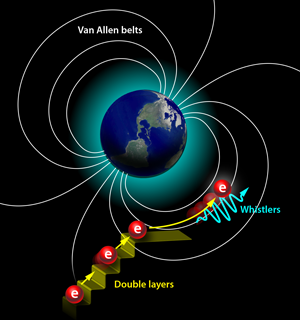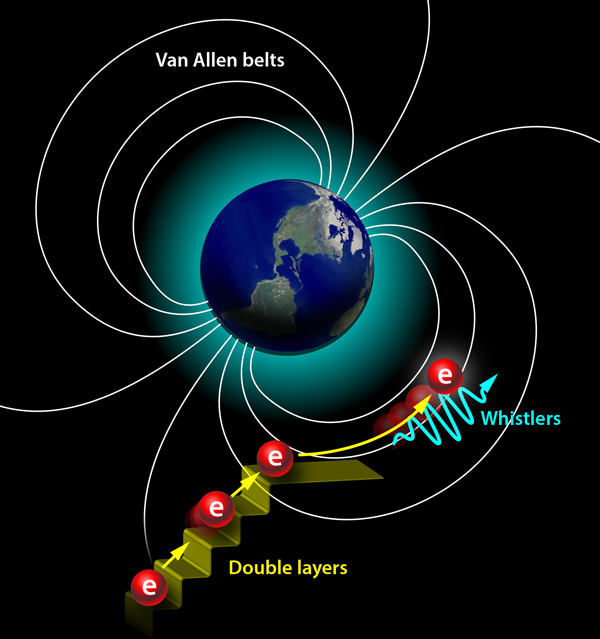A Particle Accelerator in the Radiation Belts
One of the most intriguing problems of astrophysics is the existence in a variety of environments of anomalously high-energy particles, for example, extragalactic cosmic rays up to electron volts (eV). Closer to home, the Earth’s Van Allen radiation belts, discovered at the dawn of the space age, contain some electrons and ions with energies of millions of eV. In spite of a wealth of observations and many proposed models, clarifying the various acceleration mechanisms represents a long-standing challenge. In Physical Review Letters, Forrest Mozer at the University of California, Berkeley, and colleagues [1] report the first in situ observations in the radiation belts of streams of thousands of “double layers”—moving sheets of separated positive and negative charge that have long been thought to accelerate electrons. Data from NASA’s Van Allen probes show an astonishing potential drop (voltage difference) of a million volts passing the satellites, in streams that appear in association with strong enhancements of -MeV electron fluxes. The energy that electrons can gain in the double-layer electric field could be the missing step in the radiation-belt acceleration scenario that has been envisaged by researchers in the last few years (see Fig. 1).
The magnetosphere is a large region of space where the Earth’s magnetic field controls the motion of charged particles, namely electrons, protons, and other ion species, which form space plasmas. Energetic particle populations are observed in various parts of the magnetosphere [2,3]. Recently, using the Van Allen probes launched in August 2012, researchers showed that electrons with energies over MeV had been accelerated within the radiation belts [4], rather than being transported from elsewhere. But what is the local acceleration mechanism? The discovery by the STEREO spacecraft [5] of very strong “whistler” waves in the Earth’s radiation belts suggested that electrons could “surf” these waves to accelerate to MeV energies. Whistlers are particular electromagnetic modes propagating in a magnetized plasma that can resonantly interact with fast particles. However, to be effective in the radiation belts, this process requires a seed population of electrons that already have energies of about a hundred keV [6,7], much larger than the electron thermal energy.
A double layer is a perturbation that occurs in a “collisionless” plasma, traveling along the magnetic field and consisting of two layers of charge. As in a parallel-plate capacitor, the electric field between the layers gives rise to a corresponding potential drop. In space plasmas, the two charged layers grow out of plasma instabilities, and they do not recombine because they are moving, so, for instance, an electron density enhancement leads the ion density enhancement. The Van Allen probes are equipped with measuring spheres tethered on -meter-long cables that allow determination of the three-dimensional electric field at samples per second. For occasional short periods, data can be taken much faster, at samples per second. Such a high time resolution is needed to characterize double layers, since their transit past the spacecraft typically lasts less than a millisecond.
The remarkable result reported by Mozer et al. is that streams of double layers were observed in one minute: it was like ascending a stairway of steps very quickly. Each double layer is detected as an electric field spike of a typical duration of milliseconds and a potential step of about volts. The train of double layers propagates along the magnetic field lines at kilometers per second, which is the speed of an unusual mode called electron acoustic waves that can exist in a plasma containing both hot and cold electron populations [8].
All the electric field spikes had the same sign along the magnetic field. Careful analysis of lower-resolution data ( samples/second) implies that the total potential change passing the spacecraft over minutes was over a million volts. Individual electrons did not experience this total potential but, rather, bursts of double layers that give potential drops of tens of kilovolts [1], which the electrons may encounter several times as they bounce from pole to pole along the Earth’s magnetic field lines. This mechanism can explain how some electrons attain the more than -keV energy required before the resonant electron-whistler interaction can further accelerate them to MeV energies.
Mozer et al. also present more direct evidence that double layers provide the seed electrons for acceleration by whistler modes [1]. Large-amplitude whistler waves were observed on October 8 and 9, 2012, but only on the latter day did the -MeV relativistic electron fluxes increase by nearly three orders of magnitude. On the earlier day, October 8, no double-layer streams were observed in conjunction with the whistlers, suggesting that large-amplitude whistlers alone cannot accelerate electrons if the seed population is absent. Conversely, on October 9, double layers were observed, together with large-amplitude whistlers and a marked increase in the relativistic electron fluxes. Therefore, the acceleration of MeV electrons is a two-step process: first double-layer streams and then whistler resonant interaction.
These results have several far-reaching implications. First, they complete the long-standing goal of understanding extreme acceleration of electrons in the Earth’s radiation belts. Second, the observations show that the Earth’s magnetosphere can be used as a laboratory for studying energetic particle acceleration while “changing” the experimental conditions (with or without double layers and with or without whistlers), just as we would do in our laboratory. Third, a detailed understanding of the acceleration mechanisms in the Earth’s magnetosphere can be exported to other astrophysical systems, like the solar corona, with observed particle energies up to GeV, and to the other planetary magnetospheres, as well as far more distant objects like supernova remnants [9], with cosmic-ray energies as high as eV and more. Indeed, beams of particles moving along the magnetic field, which are the likely origin of double layers, are also envisaged for those objects. This prompts new questions: Why are electron acoustic waves and the associated double layers formed? Why do double layers occur in streams of thousands? What conditions allow such large electric potential differences to exist? What drivers of the magnetospheric dynamics can also be found in other astrophysical systems?
These results join other observations and models of near-Earth phenomena that have broader astrophysical relevance. For example, terrestrial gamma rays in the upper atmosphere may give insight into the origin of gamma-ray bursts from the most distant objects in the Universe, and magnetic-field reconnection similar to that at the Earth’s magnetopause may accelerate high-energy cosmic rays. These findings show that studying geospace plasmas is not only worthwhile per se, but that the Earth’s broad environment is a real laboratory for high-energy astrophysics.
References
- F. S. Mozer, S. D. Bale, J. W. Bonnell, C. C. Chaston, I. Roth, and J. Wygant, “Megavolt Parallel Potentials Arising from Double-Layer Streams in the Earth’s Outer Radiation Belt,” Phys. Rev. Lett. 111, 235002 (2013)
- R. M. Millan and D. N. Baker, “Acceleration of Particles to High Energies in Earth’s Radiation Belts,” Space Sci. Rev. 173, 103 (2012)
- J. Birn, A. V. Artemyev, D. N. Baker, M. Echim, M. Hoshino, and L. M. Zelenyi, “Particle Acceleration in the Magnetotail and Aurora,” Space Sci. Rev. 173, 49 (2012)
- G. D. Reeves et al., “Electron Acceleration in the Heart of the Van Allen Radiation Belts,” Science 341, 991 (2013)
- C. Cattell et al., “Discovery of Very Large Amplitude Whistler-mode Waves in Earth’s Radiation Belts,” Geophys. Res. Lett. 35, L01105 (2008)
- I. Roth, M. Temerin, and M. K. Hudson, “Resonant Enhancement of Relativistic Electron Fluxes during Geomagnetically Active Periods,” Ann. Geophys. 17, 631 (1999)
- Y. Omura, N. Furuya, and D. Summers, “Relativistic Turning Acceleration of Resonant Electrons by Coherent Whistler Mode Waves in a Dipole Magnetic Field,” J. Geophys. Res. 112, A06236 (2007)
- I. Roth and M. K. Hudson, “Simulations of Electron Beam Excited Modes in the High-altitude Magnetosphere,” J. Geophys. Res. 91, 8001 (1986)
- M. E. Dieckmann and A. Bret, “Particle-In-Cell Simulation of a Strong Double Layer in a Nonrelativistic Plasma Flow: Electron Acceleration to Ultrarelativistic Speeds,” Astrophys. J. 694, 154 (2009)





